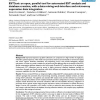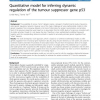721 search results - page 61 / 145 » Biological Network Inference Using Redundancy Analysis |
102
click to vote
BMCBI
2008
14 years 10 months ago
2008
Background: Expressed sequence tag (EST) collections are composed of a high number of single-pass, redundant, partial sequences, which need to be processed, clustered, and annotat...
IJBRA
2008
14 years 9 months ago
2008
Abstract Observing behaviors of protein pathways and genetic networks under various environments in living cells is essential for unraveling disease and developing drugs. For that ...
BMCBI
2010
14 years 10 months ago
2010
Background: The availability of various "omics" datasets creates a prospect of performing the study of genomewide genetic regulatory networks. However, one of the major ...
NIPS
1998
14 years 11 months ago
1998
Inference is a key component in learning probabilistic models from partially observable data. When learning temporal models, each of the many inference phases requires a complete ...
BMCBI
2007
14 years 10 months ago
2007
Background: The availability of microarrays measuring thousands of genes simultaneously across hundreds of biological conditions represents an opportunity to understand both indiv...


